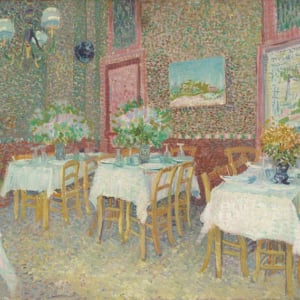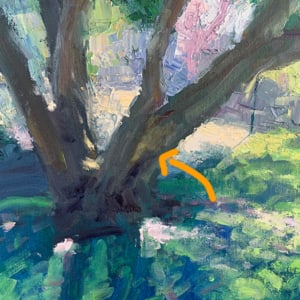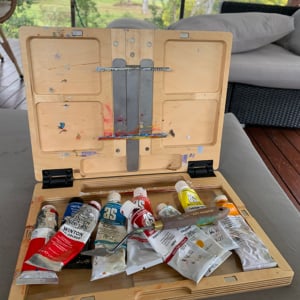Framing as a composition technique involves positioning shapes and other elements to “frame” and draw attention to certain areas in your painting. For example, you could position a tree or building to frame your focal point in the center.
The idea behind framing as a composition technique is much the same as why we physically frame our paintings (the physical frame draws attention to the painting as a whole).
In this post, I run through some examples of framing to give you an idea of what it is and how you can use it in your own paintings. I cover:
- Framed by Nature
- Framed by Darkness
- Framed by Architecture
- Key Takeaways
- Want to Learn More?
- Thanks for Reading!
Framed by Nature
I will start with one of my recent paintings which depicts Queenstown from across the lake in the Botanical Gardens. The colors looked almost surreal at the time. The idea for this painting was to use the dark trees and land in the foreground to frame the glimmering colors of Queenstown in the distance.

In Storm in the Mountains, the dramatic clouds frame the distant, blue mountains. It is possible that Bierstadt used his creative license to purposefully arrange the clouds in this way, rather than painting the landscape exactly how he saw it. After all, he was known to exaggerate the landscape in his paintings to make them appear more romantic and grand. But we will never know if this was actually the case.
Also, notice how the frame does not enclose the whole painting, just a small area. Framing as a composition technique is not limited to the boundaries of the painting. It could be used to frame small but important areas (or even unimportant areas).
In this case, the distant mountains are faint and weak, yet our eyes are drawn towards the area due to the dramatic frame created by the clouds. The frame adds significance to an otherwise subtle area.

The previous two paintings are more obvious examples of framing, but most of the time framing takes a more subtle role. In Paul Cézanne’s painting below, the tree provides a partial frame around the key feature of the painting: Mont Sainte-Victoire. But, the frame is fairly weak as the tree blends in with the rest of the painting.

In Morning in a Pine Forest, notice how Ivan Shishkin arranged the nature to frame the four bears playing around the middle of the painting. In particular, the two large trees on the left-hand and right-hand sides of the painting, the uplifted roots in the bottom left-hand corner, and the dying leaves in the bottom right-hand corner.

Below is a lop-sided frame by Thomas Cole in The Oxbow. The dark clouds and vegetation in the foreground frame the organized and growing civilization in the distance.

Framed by Darkness
Darkness alone can form an effective frame for lighter areas in your painting. In my painting Secrets on the Lake, the dark shadows at the bottom and left-hand side frame the lighter areas in the painting.
Tip: A frame of darkness is usually more effective than a frame of light because our eyes tend to be drawn towards lighter areas.

In John Singer Sargent’s A Dinner Table at Night, the darkness in the background frames the people dining at the table.
The positioning of the man plays a significant role in containing our attention around the light areas. His body blocks the right-hand side of the painting and his line of vision acts as an implied line which pulls you in through the painting (we want to look where he is looking). By contrast, the woman in the center makes a powerful statement by staring right back at us.

Framed by Architecture
Architecture tends to provide a more solid and obvious frame compared to frames created by nature. For this reason, you need to be careful with how you use architecture frames; overdoing it could make your painting appear rigid and blunt.
In the painting below by Sir Winston Churchill (more commonly known for his role as Prime Minister of the United Kingdom), the bridge and its cast shadow form a strong and rigid frame for the buildings and high-key colors in the distance.

In Childe Hassam’s The Goldfish Window, there are several frames used in the painting: the primary frame created by the curtains and chairs on the outskirts of the painting, and the secondary frames created by the windows.

In Claude Monet’s painting below, the ceiling of the train station provides a rigid frame for the background. The frame in this case actually forms the majority of the painting, with the light background taking up only a small portion. This leads to an important note about balance: a small, light and active area can have the same or more impact than a large, dark and vague area.

Key Takeaways
Here are some of the key takeaways from this post which you can apply to your own paintings:
- The idea behind framing as a composition technique is much the same as the idea behind physically framing our paintings: to focus our attention.
- There are many ways you could create frames within your painting, such as by using nature, darkness or architecture.
- Darkness is usually a more effective frame than light.
- People will be drawn towards areas within a frame, so it makes sense to place important features there.
Also, before I wrap this up, I should note that framing is not an essential composition technique by any means. Some paintings utilize framing, some don’t. It is just one of the many tools at your disposal.
Want to Learn More?
You might be interested in my Painting Academy course. I’ll walk you through the time-tested fundamentals of painting. It’s perfect for absolute beginner to intermediate painters.
Thanks for Reading!
I appreciate you taking the time to read this post and I hope you found it helpful. Feel free to share it with friends.
Happy painting!
Dan Scott

Draw Paint Academy







Thanks Dan, your emails are always really informative! I enjoy reading them and picking up little tidbits to keep in mind when I’m painting. Love your Queenstown painting!
Dan, thank you. Great joy of watercolour painting is we never stop learning. And the power of experimenting never ceases to surprise me.
Dan,
Thanks for the informative message on framing. Your perspectives on art are enlightening and helpful.
Cheers,
David
Very informative, thanks for your posts.
Thanks, I paint still life’s. So I would use dark shadows for framing, right????
Thank you, Dan, this is most informative and I would love to apply it. Jennie
Excellent sharing .
Thank you so much!
Thanks for this post, Dan! It certainly points out the importance of intentionally planning a composition.
Thanks for this information, Dan. I realised I have been using this technique and seen it in other paintings without being fully aware of the framing effect. Another useful and informative post.
Hi Dan,
Interesting post, framing certainly adds interest and draws attention to the focal point of the work. Might try that a bit in my little efforts.
Didn’t realise Sir Winston was such a talent, what a great man he was !!
Your work isn’t to shabby either Dan.
Thanks again, Dave M.???
Thank you for the informative post, Dan. Great tips as always.
Thanks for sharing, Dan! I think I’ve done this without being able to articulate it, and you clarify it well. The concept is sort of a painting within a painting. I appreciate your informative posts.
I always look forward to a post from you Dan. Always insightful and straightforward. Please keep them coming!
So glad you made me realize my mistakes. Learned a lot already. With thanks
Susanne
I am soooo very thankful for all the information you share. They have surely enlightened,guided and helped me in many ways. You are truly a great inspiration. Thanks a lot and a big God Bless!!!
Hi Dan really good post.. Love you secrets of the lake painting!
Great tips helping me a lot
Shirley
Happy 30th birthday, Dan. I love the features you send–they make my visits to art galleries and museums more meaningful. They also help to inform my watercolor compositions. It’s fun to learn about the artists whose work you highlight. I hope you continue for a very long time.